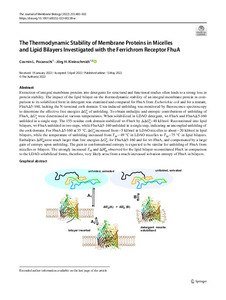| dc.date.accessioned | 2023-01-04T09:19:37Z | |
| dc.date.available | 2023-01-04T09:19:37Z | |
| dc.date.issued | 2022-05-13 | |
| dc.identifier | doi:10.17170/kobra-202301037285 | |
| dc.identifier.uri | http://hdl.handle.net/123456789/14325 | |
| dc.description.sponsorship | Gefördert im Rahmen des Projekts DEAL | |
| dc.language.iso | eng | |
| dc.rights | Namensnennung 4.0 International | * |
| dc.rights.uri | http://creativecommons.org/licenses/by/4.0/ | * |
| dc.subject | Thermodynamic stability | eng |
| dc.subject | Outer membrane protein | eng |
| dc.subject | Membrane protein folding | eng |
| dc.subject | Lipid bilayer | eng |
| dc.subject | Detergent micelle | eng |
| dc.subject | β-barrel | eng |
| dc.subject.ddc | 570 | |
| dc.title | The Thermodynamic Stability of Membrane Proteins in Micelles and Lipid Bilayers Investigated with the Ferrichrom Receptor FhuA | eng |
| dc.type | Aufsatz | |
| dcterms.abstract | Extraction of integral membrane proteins into detergents for structural and functional studies often leads to a strong loss in protein stability. The impact of the lipid bilayer on the thermodynamic stability of an integral membrane protein in comparison to its solubilized form in detergent was examined and compared for FhuA from Escherichia coli and for a mutant, FhuAΔ5-160, lacking the N-terminal cork domain. Urea-induced unfolding was monitored by fluorescence spectroscopy to determine the effective free energies ΔGᵒᵤ of unfolding. To obtain enthalpic and entropic contributions of unfolding of FhuA, ΔGᵒᵤ were determined at various temperatures. When solubilized in LDAO detergent, wt-FhuA and FhuAΔ5-160 unfolded in a single step. The 155-residue cork domain stabilized wt-FhuA by ΔΔGᵒᵤ~ 40 kJ/mol. Reconstituted into lipid bilayers, wt-FhuA unfolded in two steps, while FhuAΔ5-160 unfolded in a single step, indicating an uncoupled unfolding of the cork domain. For FhuAΔ5-160 at 35 °C, ΔGᵒᵤ increased from ~ 5 kJ/mol in LDAO micelles to about ~ 20 kJ/mol in lipid bilayers, while the temperature of unfolding increased from Tₘ ~ 49 °C in LDAO micelles to Tₘ ~ 75 °C in lipid bilayers. Enthalpies ΔHᵒₘwere much larger than free energies ΔGᵒᵤ, for FhuAΔ5-160 and for wt-FhuA, and compensated by a large gain of entropy upon unfolding. The gain in conformational entropy is expected to be similar for unfolding of FhuA from micelles or bilayers. The strongly increased Tₘ and ΔHᵒₘ observed for the lipid bilayer-reconstituted FhuA in comparison to the LDAO-solubilized forms, therefore, very likely arise from a much-increased solvation entropy of FhuA in bilayers. | eng |
| dcterms.accessRights | open access | |
| dcterms.creator | Pocanschi, Cosmin L. | |
| dcterms.creator | Kleinschmidt, Jörg Helmut | |
| dc.relation.doi | doi:10.1007/s00232-022-00238-w | |
| dc.subject.swd | Thermodynamische Stabilität | ger |
| dc.subject.swd | Membranproteine | ger |
| dc.subject.swd | Lipide | ger |
| dc.subject.swd | Micelle | ger |
| dc.type.version | publishedVersion | |
| dcterms.source.identifier | eissn:1432-1424 | |
| dcterms.source.issue | issue 4-5 | |
| dcterms.source.journal | The Journal of Membrane Biology | eng |
| dcterms.source.pageinfo | 485–502 | |
| dcterms.source.volume | Volume 255 | |
| kup.iskup | false | |


